|
February 2007 Updates
02.27.07 (Adar 9, 5767) As most of you know, the Hebrew word mitzvah means "divine commandment" (mitzvot is the plural form). Although the word is sometimes used broadly to refer to Rabbinic (Talmudic) law, in its strictest sense the term refers to an explicit commandment given by the LORD in the Torah. In a new article I am writing, I list the 613 commandments of the Torah and provide New Testament correlations, when applicable. Please note that this is a work in progress, so some of the NT references are not yet in place...

Web site technical issues: Please note that there have been some problems with my web hosting service (i.e., router issues) and the site has been very slow lately. Hopefully this will be remedied soon, and your prayers are appreciated.
02.27.07 (Adar 9, 5767) Media Blitz to "Terminate" Jesus. As some of you may know by now, movie moguls James Cameron ("The Titanic," the "Terminator") and Israeli documentary filmmaker Simcha Jacobovici (a political science major in college) have created a new "documentary" that attempts to "prove" that Jesus' body is actually decomposed in an ancient ossuary found some 20 years ago in Israel (in a location nowhere near the historical location recorded for Jesus' burial). Of course this is an outright assault on traditional, historic Christianity, which maintains that the physical resurrection of Jesus from the dead is the cornerstone of the faith. As the Apostle Paul (Rabbi Saul) said, "For if the dead are not raised, not even Christ has been raised. And if Christ has not been raised, your faith is futile and you are still in your sins." (1 Cor 15:16-17). Apparently Cameron and Jacobovici feel it's their mission to disabuse the world by spreading the news of their "discovery" using the mass media and the standard propaganda techniques.
Here's an image of the supposed "Jesus" ossuary (I have added clearer Hebrew for the text shown on the ossuary). The word marked ??? is unclear -- even the letters do not look anything like standard Hebrew from that period. It reads something like, "Jacob, son of Joseph, ??? Yeshua" (see Matt 1:16), though the ??? letters might be part of the Shin-Vav-Ayin that form the last word:
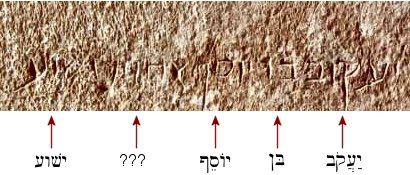 |
If it's not an outright forgery (as it appears to me), apart from the fact that the name "Jesus" (Yeshua) was a popular name at that time (appearing in 98 other tombs and on 21 other ossuaries), the Talipot tomb and ossuaries (i.e., the location of this ossuary) probably would have belonged to a rich family, which is not a historical match for Jesus of Nazareth. Moreover, this ossuary apparently was originally found with the known fake ossuary of James the Righteous, so at best we are dealing with questionable artifacts.
May God Almighty vindicate the Name of His beloved Son from the slanderers. Amen.
A closing thought on this subject. Awhile back, when the so-called "James Ossuary" was discovered, the skeptics were quick to dispute that this provided any attestation to the historical figure of Yeshua min Netzeret (Jesus of Nazareth), but now these same skeptics will hypocritically maintain that the "Jesus Ossuary" is to be seriously considered. This just goes to show you that "wisdom is justified of her children," meaning that reason is always a servant to the passions. If you WANT to believe a lie, you will always be able to find a reason to do so....
 |
On a somewhat related subject, while updating the online Hebrew glossary pages here, I ran into the old question about the phrase, "Jesus of Nazareth," and how that connects with the phrase "he shall be called a Nazarene" in Matthew 2:23.
"He shall be called a Nazarene." As you know from the Gospels, Nazareth was the home of Joseph and Mary and the site of the Annunciation, when Mary was told by the Angel Gabriel that she would have Jesus as her son. Nazareth is also assumed to be where Jesus grew up from his infancy to manhood. The town, even in Jesus' day, was known for its unbelief and general wickedness (e.g., John 1:46; Mark 6:5; Luke 4:16-29).
The word Nazareth is said to derive from netzer, meaning a "shoot" or "sprout" (or derives from natzar meaning to guard or watch [Exod. 34:7; Job 7:20; 27:18; Psa. 31:24; 34:14; Prov. 3:21; 4:23; 6:20; 13:3; 16:17; 27:18; Isa. 60:21]) but is not to be confused with the word Nazarite (nazir), or torat hanazir, which are laws concerning vows of separation given in the Torah (Num. 6:2, 13, 18ff; Judg. 13:5,7; 16:17).
What, then, do we make of Matt. 2:23 where it says, "And he went and lived in a city called Nazareth, that what was spoken by the prophets might be fulfilled: "He shall be called a Nazarene"? What verse in the Nakh (prophets) is Matthew quoting here?
None. This is not a direct quotation of a particular prophet (as the word "prophets" clearly indicates), but instead points out that Jesus' designation as a Nazarene was a term of reproach, and it is this reproach and rejection that was indeed foretold by the prophets (e.g., Ps. 22:6; Isa. 49:7; Isaiah 53; Dan. 9:26). In fact, the Talmud uses the term "Yeshu haNotzri" as a villification of the Son of God, and this usage is still seen among religious Jews who despise the Mashiach today.
 |
02.26.07 (Adar 8, 5767) This Thursday is Ta'anit Ester (the fast of Esther), observed a couple days earlier this year because the 13th of Adar (the traditional date for the fast) falls on a Shabbat. I updated the Fast of Esther page and created a PDF download that I hope you find helpful.

Purim begins Saturday night (for the Diaspora), with Shushan Purim observed in Israel a day later (the reason for the different dates of Purim is that the Jews of Shushan waged war on both the 13th and the 14th of Adar and observed the 15th as a day of festivity and rejoicing, but in all other provinces the Jews waged war on the 13th and observed the 14th as the day of celebration. Jews in Israel identify with the Jews of Shushan, and hence its celebration is called "Shushan Purim").
Nu, what does Purim teach us? Well, besides celebrating the sovereignty of God in world full of control freaks, Purim is a time to commemorate and anticipate the Kingship of the LORD God of Israel. Tyrants and all purpled princes of this age beware! You are doomed to failure, since the LORD will never forsake those who trust in Him for deliverance.
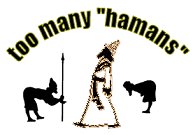
Jesus spoke of that insatiable lust within the unregenerate heart that leads to violence, oppression, and slavery of every kind:
You know that those who are considered rulers of the Gentiles lord it over them, and their great ones exercise authority over them. But it shall not be so among you. But whoever would be great among you must be your servant, and whoever would be first among you must be slave of all. For even the Son of Man came not to be served but to serve, and to give his life as a ransom for many. (Mark 10:42-45)
This message might sound a bit radical in the ears of those who have been seduced into believing that a lifestyle of self-centered fulfillment is the way to get ahead and succeed. "Respect," "pride," amour propre, self-love, etc., etc. ad nauseam ad infinitium: it's all that the world with its banal message of evil ever has to say through its stupor-inducing propaganda. But Jesus, of course, turns the world's thinking on its head by saying that true greatness is not to found in the eyes of others, but in the humble acknowledgement of our eternal indebtedness to God for everything. It is the servant, the slave, "the nonentity" who is considered great in God's kingdom. Mankind's lust for power and greatness is nothing but the ridiculous donning of a tinfoil crown.
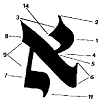
Since Jesus (Yeshua) is indeed the Master of the Universe and Mashiach, we are all long overdue to confess our "carnal neediness" for attention and praise. Why do we so crave the esteem of others when we disregard what God Himself esteems?
In anticipation of Purim, then, let me wish you and your family Purim Sameach -- with the prayer that you will stand true to your faith, despite this wicked world and its syncretizing influences... Hooray for Mordecai! -- may the LORD raise up many like him! And may Haman and his kind forever be foiled in their attempts to undermine those who call upon the Name of the LORD God of Israel. Amen.
 |
02.25.07 (Adar 7, 5767) I have been sick with the flu the last few days, but I nevertheless managed to update the weekly Torah portion for this coming Shabbat (Tetzaveh). Among other fascinating things (including the mystery of the middle light of the menorah), this week's parsha describes the priest's garments as they served in the mishkan (tabernacle), each item of which is highly symbolic of Yeshua as our Kohen Gadol (High Priest) after the order of Malki-Tzedek (Melchisedec). One thing you might miss in the description of the begadim (garments), however, is that neither the regular kohanim nor the Kohen Gadol wore shoes or slippers! In other words, they served in the mishkan (and later at the Temple) barefoot.

On the Shabbat before Purim, the weekly Parashah is supplemented with the Zachor ("remember") reading (Deut 25:17-19) in which we are commanded to remember the evil of Amalek and to eradicate it from the face of the earth. This is done because some of the Jewish sages teach that Haman was a descendant of Amalek.
Wishing you all shalom rav and happiness, despite the darkness and horror of the world around us... Yeshua is coming soon, chaverim, and I pray that we are ready.
02.23.07 (Adar 5, 5767) I am very sick with the stomach flu...
02.22.07 (Adar 4, 5767) Want to use your Ipod to study the Hebrew alphabet? Now you can! Rick Swartzentrover kindly modified the Aleph-Bet flash cards here so you can now run them directly from your Ipod! To download the files, see Unit One of the Hebrew Grammar pages.
02.21.07 (Adar 3, 5767) I added "Advanced Information" for the Hebrew letter Tsade that I hope you will find provocative and helpful:

Please note that even though I provide information about the traditional kabbalistic teachings regarding the Hebrew aleph-bet, I am not an advocate of Gnosticism or any form of traditional (i.e., medieval) Kabbalah, either of the Jewish or Christian variety. (Modern day Kabbalah actually derives from a mishmash of ancient sources, including Babylonian religion, astrology, myth and magic, Persian Zoroastrianism, Gnosticism, Pythagoreanism, and Neoplatonism). I do not agree with those people that allege that the letters of the Hebrew alphabet are (literally) "creative forces" behind a metaphysical system of divine emanations (i.e., the ten sefirot of the Zohar). Nor do I espouse any view of tikkun olam (repair of the world) that is not directly the result of the saving work of Jesus the Mashiach, blessed be He. We are saved exclusively by the grace of God, through trusting that Jesus alone is the Tzaddik whose suffering and sacrificial death atones for the sins of the world... Any view of mediating God's righteousness through ritual practices or mystical speculations is contrary to the clear teaching of the Scriptures.
 |
02.19.07 (Adar 1, 5767) I updated the weekly Torah portion for this coming Shabbat (Terumah) and created a new PDF file for you to download. Among other things, this week's parashah calls for a contribution from b'nei Israel (the children of Israel) for the construction of the Mishkan (tabernacle), a structure that would symbolize the LORD's presence among the Israelites during their sojourn to the land of Canaan.

One question that arises when we consider the mishkan is where did the Israelites get the materials required to construct it? After all, the following materials were required: gold, silver, copper, wool dyed purple and wool dyed blue, linen, goats' hair, "seal" (tachash) skins, shittim (acacia) wood, olive oil, spices, and various precious gems. This stuff normally isn't seen lying around the desert...
Various midrashim state that the gold and jewels came from despoiling the Egyptians (though some especially rare jewels were found in the desert with the manna that fell); the acacia trees came from Jacob, who foresaw the need 300 years earlier; and the required extra long beam (i.e., the middle beam for the Mishkan) came from a tree that Abraham himself had planted which the angels had chopped down and carried to the desert for the Israelites...
Later, of course, the miskhan was transformed into the Bet Hamikdash, the holy Temple. As the Midrash says, "The land of Israel is situated in the center of the world, and Jerusalem in the center of the land of Israel, and the Temple in the center of Jerusalem, and the Holy of holies in the center of the Temple, and the foundation-stone on which the world was grounded, is situated in front of the ark." - Midrash Tillin Terumah, Kedoshim
 |
02.16.07 (Shevat 28, 5767) I am sometimes asked whether I offer an audio CD to accompany the Hebrew book I wrote. Well, I actually started that project awhile back (with a cantor friend of mine reciting the readings through a high quality microphone), but the idea fizzled out because I couldn't find a publisher... In general, sales for materials like my book are next to nothing compared to the popular Christian books sold these days, so unless I am willing to self-publish (which I can't afford), these sorts of things must remain dreams.

Did you know that the Hebrew book I wrote was actually Volume 1 (of 4) that I intended to write? I have a lot of what would have been Volume 2 online here (under the Grammar section), though my book version would include many more examples from Scripture and vocabulary. Volume 3 was intended to perform a thorough study the Hebrew verb system, and Volume 4 was going to begin the serious exegesis of the Hebrew text of the Tanakh.
 
 |
02.14.07 (Shevat 26, 5767) Today, perhaps because it is "Valentine's Day," I added the Eshet Chayil blessing to the site (and also created a PDF download).
The Eshet Chayil ("a woman of valor") consists of the concluding section of the book of Proverbs (31:10-31). On the surface, Eshet Chayil appears to be a eulogy to the "perfect wife," though most commentators believe it represents an idealized allegory, variously interpreted to refer to the Shechinah, Shabbat itself, the Torah, wisdom, or the soul.
This is a beautiful blessing for your beloved, traditionally recited by the husband before Kiddush on Friday evenings. After the Shabbat candles are lit (but before the meal is eaten), the wife is praised and the children are then blessed.
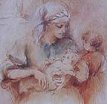
Note: Please be aware that in addition to the Hebrew graphics I created, I also uploaded the MP3 audio for the entire Eshet Chayil, and so the page may load slowly. I apologize, but I really can't do anything about that, since I thought it was important for you to hear the Hebrew recited for this blessing.
02.13.07 (Shevat 25, 5767) I added "Advanced Information" for the Hebrew letter Pey that I hope you will find provocative and helpful:
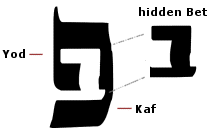
In this connection, the sages ruminated over the question, "Why did Moses stutter?"
(Adapted from Shemot Rabbah 1:31) As a very young lad, Moses was once seen throwing Pharaoh's gold crown down to the ground. Upon learning of this apparent act of insolence, Pharaoh devised a test to see if the child understood the implications of his actions. He therefore commanded that a platter with a piece of gold and a glowing piece of coal be brought before Moses and ordered the little boy to choose one. If Moses chose the gold, it would imply that he understood its value, and therefore he would be killed. On the other hand, if Moses chose the burning coal, he would be spared since he was unable to differentiate between gold and a glowing piece of coal.
Moses began to reach out for the gold when an angel pushed his hand aside and he grabbed the coal instead. Moses then immediately put his hand in his mouth, but that burned his lips and tongue so badly that he had a permanent speech impediment as a consequence.
Later, when God commissioned Moses to speak to the children of Israel, he protested to the LORD that he was kevad peh - "heavy of mouth" and kevad lashon, "heavy of tongue," and therefore unable to speak on behalf of the LORD (Ex. 4:10). God persisted, however, and compensated for Moses' speech defect by allowing him to use the name eheyh ("I AM") for His Name (Ex. 3:13-4).
Another midrash says that at age 80, Moses was given a "new mouth" to teach the people with, and yet another says that it was a sign to the Israelites in Egypt that Moses, the stutterer, could speak the divine Name perfectly when he stood before the people as God's mediator.
 |
02.11.07 (Shevat 23, 5767) I updated the weekly Torah portion for this coming Shabbat (Mishpatim) and created a new PDF file for you to download. Among other things, this parashah includes the account of the various civil laws - bein Adam L'Chavero "(between man and his fellow man") - that were to mark the lifestyle of the redeemed people of the LORD God of Israel.
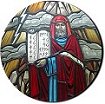
Note: This Shabbat (i.e., the Shabbat preceding Rosh Chodesh Adar) is called Shabbat Shekalim (the Sabbath of Shekels). The Maftir (additional reading) from Exodus (30:11-16) describes the census of every Jew and the obligation to give a half-shekel terumah (contribution) during the month of Adar to pay for the public korbanot (sacrifices) offered in the Bet Hamikdash (Temple) in Jerusalem. For us, it might be a time to remember those who offer personal sacrifices so that we also might draw closer to God...
02.09.07 (Shevat 21, 5767) This site has been under attack from hackers recently, and I would appreciate it if any of you who have faith in the LORD God of Israel to pray that this work will be protected.... Most of the hacking attempts have tried to slow the site down by chewing up bandwidth or by otherwise interfering with its operation. If you would pray that the hackers would go away and leave this site alone, I would appreciate it. Todah.
02.06.07 (Shevat 18, 5767) Based on a helpful criticism I received from a friend (regarding the use of the word ekklesia in the LXX and in the NT), I have revised my article, "Israel and the Church - What's the Relationship?"
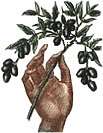
Warning: The following is a bit technical, so if it's not your "cup of tea,"
simply scroll past it...
The word "church" does not appear in English translations of the Old Testament (as it does in the New Testament). The Greek translation of the OT (called the Septuagint or LXX) uses the word ekklesia (from ek- + kaleo, "to call") for two Hebrew words that both refer to a "congregation" or "assembly": kahal and 'edah. Kahal (from the Hebrew kol, "voice") is generally translated as "assembly" or "congregation" in English (though other words are sometimes used). The LXX uses the word sunagoge (synagogue) for the Hebrew word 'edah (from the Hebrew word 'ed, meaning witness or testimony), which is usually translated as "assembly" in English. Most Hebrew scholars consider kahal and 'edah to be synonyms (see Num 20:1-13), even though they are based on different word roots.
Here's a quick summary of the usage of kahal and 'edah in the LXX, NT, and English:

What is puzzling is that the Greek translators did not appear to be consistent when translating kahal, since sometimes they chose the word ekklesia, whereas in 36 places they chose the word sunagoge. The word 'edah, however, seems to be consistently translated as sunagoge. From my comparison of the terms, it seems that the word kahal conveys the idea of a general assembly, whereas the word 'edah conveys the idea of assembling at a specific time mo'ed ("appointed time") or at a particular place of meeting (ohel mo'ed) for a particular purpose. In other words, the kahal is simply a group of some kind, whereas the 'edah is an assembly brought together for a specific purpose, often for a meeting with the LORD God of Israel.
The reason I am providing all this detail is because in the New Testament the word ekklesia is translated as "Church" in our English Bibles, and the question naturally arises as to whether this ekklesia is an extension of the kahal (or 'edah) of the Old Testament or perhaps something entirely new in God's plan and purposes. This is perhaps the crucial question regarding the relationship between Israel and the Church, and a lot of the discussion hinges on how we decide to answer it.

It appears to be a major fault of various English translations of the "Christian Bible" to have used the word "Church" for the Greek word ekklesia in the New Testament, since this suggests an anti-Jewish bias in their work by implying that there is a radical discontinuity between "Israel" and the ekklesia of Jesus (i.e., the "Church"). In other words, if the same Greek word (ekklesia) is used in both the LXX and the NT, then why was a new word coined for its usage in the English translation of the New Testament? Why not rather translate the word as it was used in the LXX, or better still, as it was used in the OT Scriptures?
For more about this issue, please see the article here.
02.05.07 (Shevat 17, 5767) I updated the weekly Torah portion for this coming Shabbat (Yitro) and created a new PDF file for you to download. Among other things, this parashah includes the account of the giving of the Ten Commandments.
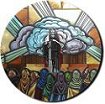
 |
02.04.07 (Shevat 16, 5767) I made a change to the new article I wrote ("Israel and the Church - What's the Relationship?") by including information about the rejection of the Jerusalem Church by the leadership of ethnic Israel, and how that factored in to the eventual divide between Rabbinical Judaism and the early Jewish Church. This additional information is important since it lends some balance to the discussion and explains why many of the Gentile Christian teachers of the first few centuries advocated severing the Church from its historic Jewish roots. This addition does not detract from the conclusion of the article, however, namely that the Church needs to repent and embrace the fact that it has been incorporated into the remnant of Israel (and not the other way around, as is commonly taught in most Churches).
 |
02.02.07 (Shevat 14, 5767) Do Christians become Jewish on account of their relationship to Jesus? If so, do they then replace the Jewish people in God's plan as the new "Chosen People" and thereby inherit the promises originally given to Israel? Just what is a Jew and what is a Christian, anyway? How should we understand the relationship between the Church and Israel?
The subject regarding the relationship of the Church and Israel is a passion of mine, primarily because I often interact with Gentile Christians who are unaware of how incredibly indebted they are to the Jewish people for their faith. Because of this, I just finished a first draft of a new article ("Israel and the Church - What's the Relationship?") which I hope might clarify some of the reasons for the Church's indebtedness to Israel. I also hope this article might encourage all of us to more fully savor the Jewish roots of our faith in Jesus. I hope it will bless you.

Happy Tu B'Shevat! Tonight at sundown begins the 15th of Shevat, the "New Year of Trees" celebrated in the land of Israel. Trees are one of the most beautiful things in the world to me, and I am especially grateful to the LORD God of Israel for helping me mediate and write about the metaphor of the Olive Tree in my last article during this time of year.

|



















